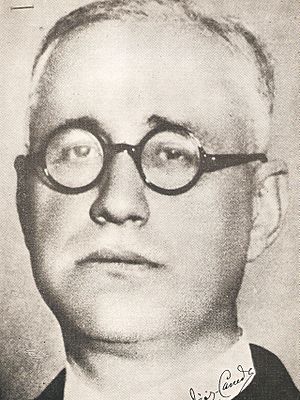Enrique Díez Canedo facts for kids
Quick facts for kids
The Most Excellent
Enrique Díez-Canedo
|
|
|---|---|
 |
|
| Born |
Enrique Díez-Canedo Reixa
7 January 1879 Badajoz, Spain
|
| Died | 6 June 1944 (aged 65) Cuernavaca, Mexico
|
| Seat R of the Real Academia Española | |
| In office 1 December 1935 – 6 June 1944 |
|
| Preceded by | Juan Gualberto López-Valdemoro de Quesada |
| Succeeded by | Luis Martínez Kléiser |
Enrique Díez-Canedo Reixa (born in Badajoz, Spain, on January 7, 1879 – died in Cuernavaca, Mexico, on June 6, 1944) was a Spanish writer. He was a poet, a translator, and a literary critic. He helped shape modern literature in Spain.
Contents
Enrique's Early Life and Education
Enrique's family moved around a lot when he was young. They lived in places like Badajoz, Vigo, and Barcelona. Sadly, his parents passed away when he was still young. This meant he became an orphan.
After this, he moved to Madrid. There, he studied Law at university. Once he finished his studies, he started teaching. He taught art history at a school called Escuela de Artes y Oficios. He also taught French language and literature at the Escuela Central de Idiomas.
Enrique's Writing Career
Enrique was very active in the literary world. He was part of a group called the Ateneo. Here, he helped organize special events. These events honored famous writers like Rubén Darío and Benito Pérez Galdós.
He also spent time at the Café Regina. There, he became friends with Manuel Azaña, who later became a president of Spain. Enrique started writing poetry and published his first poems in 1906. The book was called Versos de las horas.
At the same time, he began writing for newspapers. In 1903, he published a poem in El Liberal. He also wrote for other magazines like Renacimiento. Soon, he started writing about books and art. He was a poetry critic for La Lectura magazine. He also wrote about art for Diario Universal and Faro. These publications shared new ideas from young thinkers. He also wrote for Revista Latina and Revista Crítica. Later, he became a theater critic for El Globo in 1908. He even contributed to an important magazine called Prometeo.
Enrique's Diplomatic Work
From 1909 to 1911, Enrique lived in Paris, France. He worked there as a secretary for the Ecuadorian ambassador. Even while working in diplomacy, he kept writing. He wrote for Spanish newspapers like España, El Sol, and La Voz. He also wrote for La Nación in Buenos Aires, Argentina. In 1921, he worked with his friend, the Spanish poet Juan Ramón Jiménez, on a magazine called Índice.
Enrique as a Mentor to Writers
Enrique Díez-Canedo was a great supporter of new writers. He helped many young authors get their start. For example, he published the first poems of León Felipe in España magazine. He also helped Juan Ramón Jiménez publish some of his works in El Sol. Thanks to Enrique, a poem by Gerardo Diego appeared in España. He often wrote reviews and critical articles about the books these new writers were publishing. He gave helpful feedback and praise.
Enrique as a Translator
Enrique was also a talented translator. A translator changes books or writings from one language into another. He mostly translated works from English and French into Spanish. He also translated from Catalan and German. He translated books by famous authors like Paul Verlaine, Michel de Montaigne, H. G. Wells, and Walt Whitman.
In 1935, Enrique was chosen to be a member of the Real Academia Española. This is a very important group that looks after the Spanish language. During the Spanish Civil War, he continued to write and direct a magazine called Madrid. He also took part in an international meeting for writers.
Enrique's Main Works
Enrique Díez-Canedo wrote many books. Here are some of his most well-known works:
- Versos de las horas, 1906 (poetry)
- La visita del sol, 1907 (poetry)
- La sombra del ensueño, 1910 (poetry)
- Imágenes, 1910 (poetry)
- Sala de retratos, 1920 (prose, which is like regular writing)
- Conversaciones literarias, 1921 (literary criticism, where he wrote about other books)
- Algunos versos, 1924 (poetry)
- Epigramas americanos, 1928 (poetry)
- Los dioses en el Prado, 1931
See also
 In Spanish: Enrique Díez Canedo para niños
In Spanish: Enrique Díez Canedo para niños

